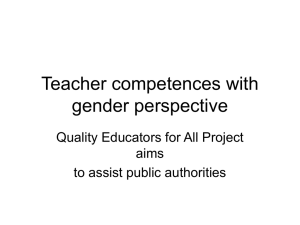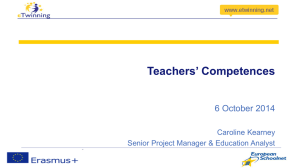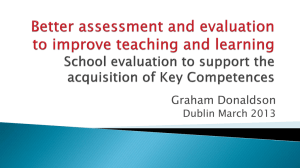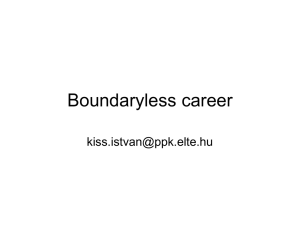Matching competences in higher education and economy:
advertisement
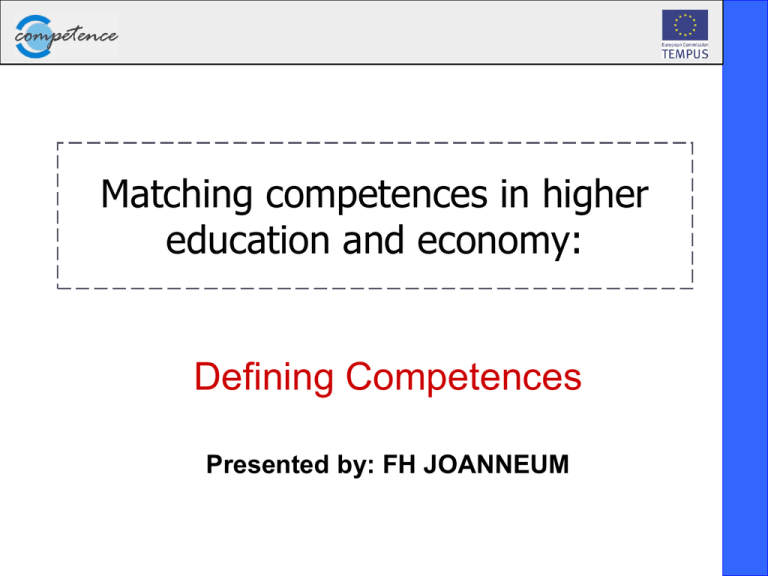
Matching competences in higher education and economy: Defining Competences Presented by: FH JOANNEUM Questions and Aims: What is a Competence Catalogue? – Why is it good to have one ? How do we start in getting one ? “The Western Balkan countries are formally committed members of the Bologna process, and all are currently engaged in implementation. This is a unique opportunity to participate in the positive restructuring of national systems to create an inclusive European Higher Education Area that benefits all citizens and countries.” (Dubrovnik Forum on Higher Education Reform, 27-29.September 2010) 1: Why do we need it ? Defining competences The competence catalogue includes all the general and the specific competences of a degree programme. Together they make up the profile of the future graduates. • Each single competence will be related to one or more courses of the degree programme by the competence matrix later on. • The competence catalogue is the basis for the competence based teaching approach. All other steps refer to it. • 1: Competence Catalogue The Competence Catalogue University Competence Catalogue Course A Specific competences for course A. Course B Specific competences for course B. .... ... Course N Specific competences for course N. Generic competences of the University. The competence catalogue is the basis of a university programme and represents it’s learning goals. The list can be read in different ways: • it is the profile of the degree and of the future graduate; • it reflects the commitment to society, the result teaching; • it is the guide for all teaching activities within the programme; • it is the starting and end point of the teaching-learning process. Academic courses, subjects and learning activities will be planned with a view to competences and learning outcomes will be assessed in terms of competences, i.e., the extent to which each student has acquired the proposed competences. 1: Competence Catalogue Why is it important to have a catalogue of competences? As a first step specific and general competences need to be defined for each degree program. There is a number of relevant stakeholders / sources which should be involved in this process National legislation EHEA requirements Labour market needs University prerequisites Student needs 1: Including Stakeholders and Sources Defining competences There is a broad base of European initiatives supporting the idea of competence based teaching. Everyone interested in the topic should look up the following: The European Framework for key competencies The European Qualification Framework (EQF) The Bologna Process and the Bologna 2020 declaration The European Employment Strategy (EES) The ECTS System Bergen Declaration If you are interested tart with: http://www.ehea.info http://ec.europa.eu/education/lifelong-learning-policy/doc44_en 1: Including Stakeholders and Sources EHEA requirements Each degree programme has its own list of competences, consisting of a set of general competences and a set of specific ones. • The general competences should be the same for each degree programme at a particular university. Usually their number is limited. The emphasis to certain general competences can become a defining factor for the way of teaching of the university. • The specific competences are different for each degree programme, they are greater in number, they will define the actual content and knowledge specific to each degree programme. 1: Including Stakeholders and Sources University Prerequisits In the project COMPETENCE a set of nine general competences has been designed. These competences usually are a good starting point. GROUP WORK Please use your handouts titled E1: Defining General Competences In the first part you are asked to work alone, in the second part please team with 2-3 other persons for discussion groups. The results of the group work will be discussed in the plenum 1: Including Stakeholders and Sources Defining general competences We suggest defining a basic set of specific competences using the curriculum and syllabi of the courses involved. GROUP WORK Please use your handouts titled E2: Defining specific Competences In the first part you are asked to work alone, in the second part please team with 2-3 other persons for discussion groups. The results of the group work will be discussed in the plenum 1: Including Stakeholders and Sources Defining specific competences Labour Market and Student Needs One possibility to gather input from all involved stakeholders is a Focus Group Interview: A focus group is a form of qualitative research in which a group of people are asked about their attitude towards a product, service, concept, advertisement, idea, or packaging. Questions are asked in an interactive group setting (preferably a round table) where participants are free to talk with other group members. Focus groups provide researchers with initial ideas in the exploratory part of a study, they can be useful in the process of interpretation and evaluation of results and situations and they can produce further research questions. 2: Focus Group Guidelines Focus Group Interview FGI - Participants Ideal setup are 5-6 participants and a moderator around a round table. Usually the interview will not last longer then two times 45min, with a 15 min break. Plan for 2 hours Participants must have a specific experience with the topic: preferably experienced professors and administrators who are involved in the design of curricula or courses. A suggestion: 2 professors or administrators, 2 employers, 1 graduate, 1 student or decision maker FGI - Questions Ideal number are 2-4 questions Aim of the questions: Analyse the existing knowledge about competence based teaching Specify important competences for university and employers Find the gap between what is taught and what is needed Find possible obstacles for introducing competence based learning Complexity of the questions: Interview questions should be easily understandable, short (the participants should remember them) and focused on the topic. Example Questions How would you describe competence based learning? What does the term competence mean to you? What are the most important skills, abilities, and knowledge students should acquire during their studies? What are the most practice-relevant skills, abilities and knowledge? (Advice to the moderator: Ask for details for the raised competences. Try to explore their meaning.) Where do you perceive the gap between competences delivered at the university and those needed in the labour market? Are students capable in delivering the relevant knowledge and competences in the work place. How would you include competence based learning in your university in the future? Where do you see prerequisites, starting points and possible barriers? FGI – Group Work The Focus Group content can be designed together in the following GROUP WORK Please use your handouts titled E3: Working on the Focus Group In the first part you are asked to work alone, in the second part please team with 2-3 other persons for discussion groups. The results of the group work will be discussed in the plenum Next Steps • Please define these yourself More information can be found in: the Competence Manuals, the Competence website (http://www.link-competences.org/) and at the competence centre. Thank you very much for your attention!
